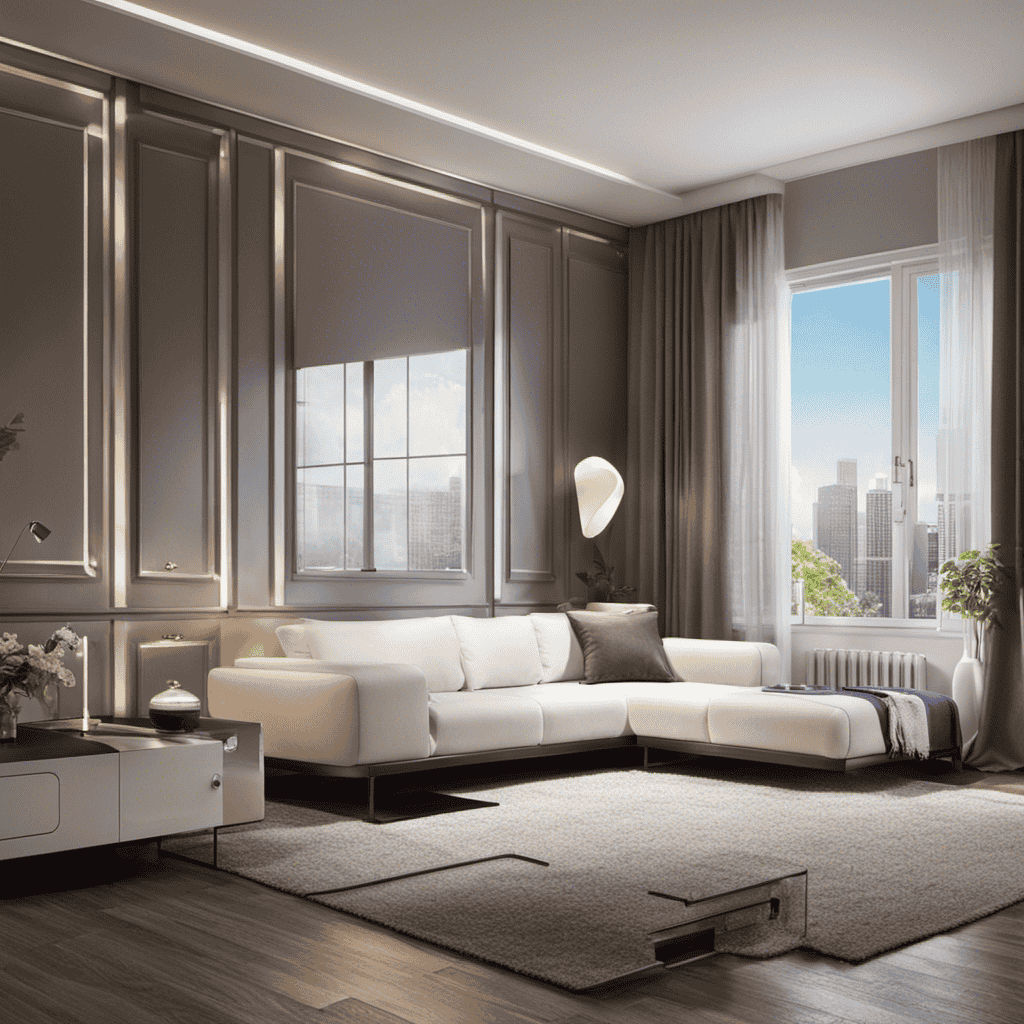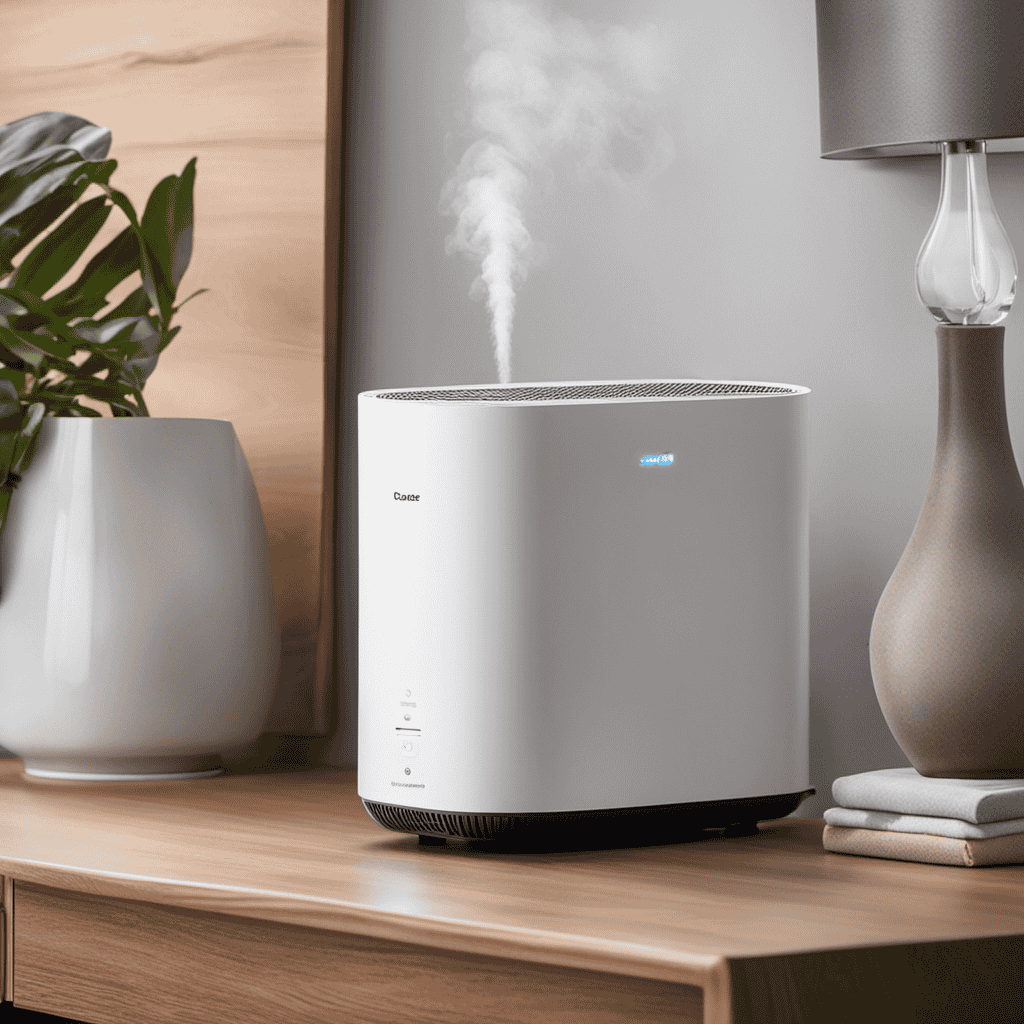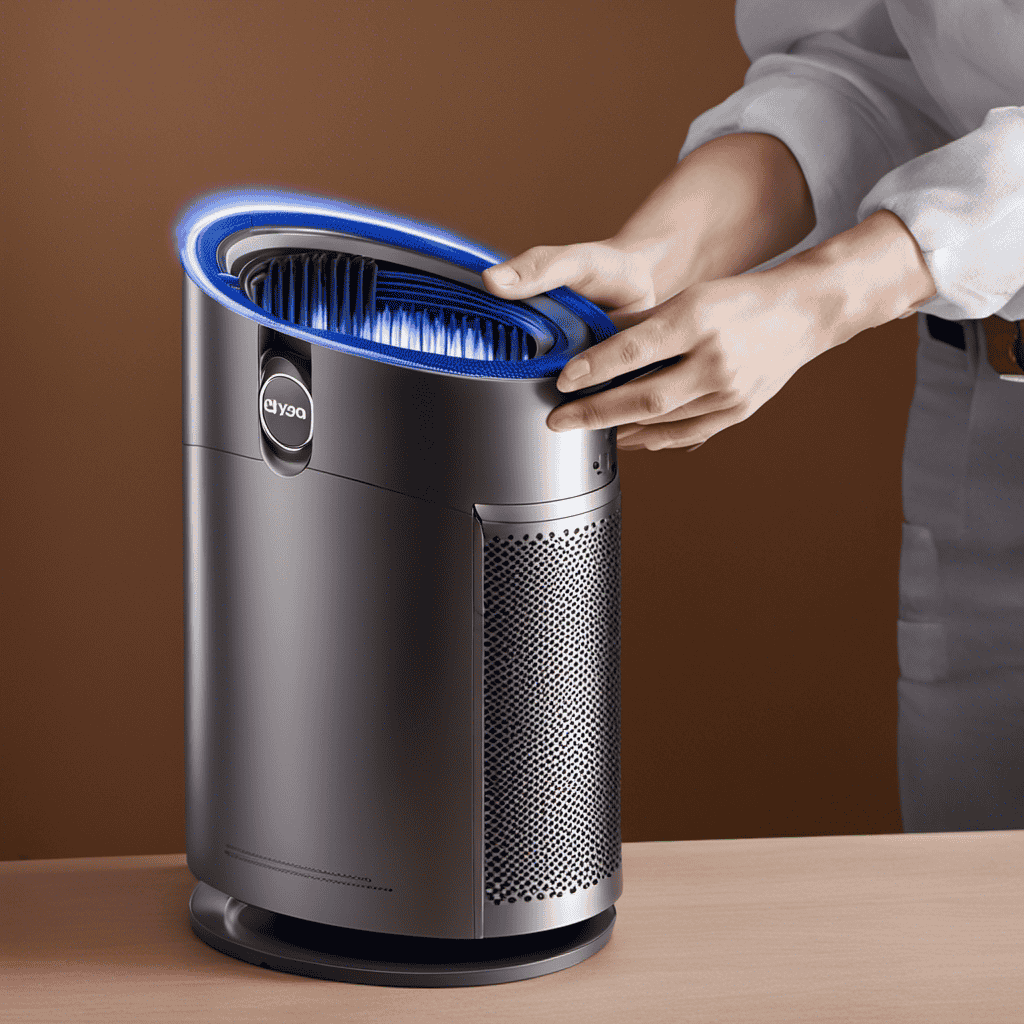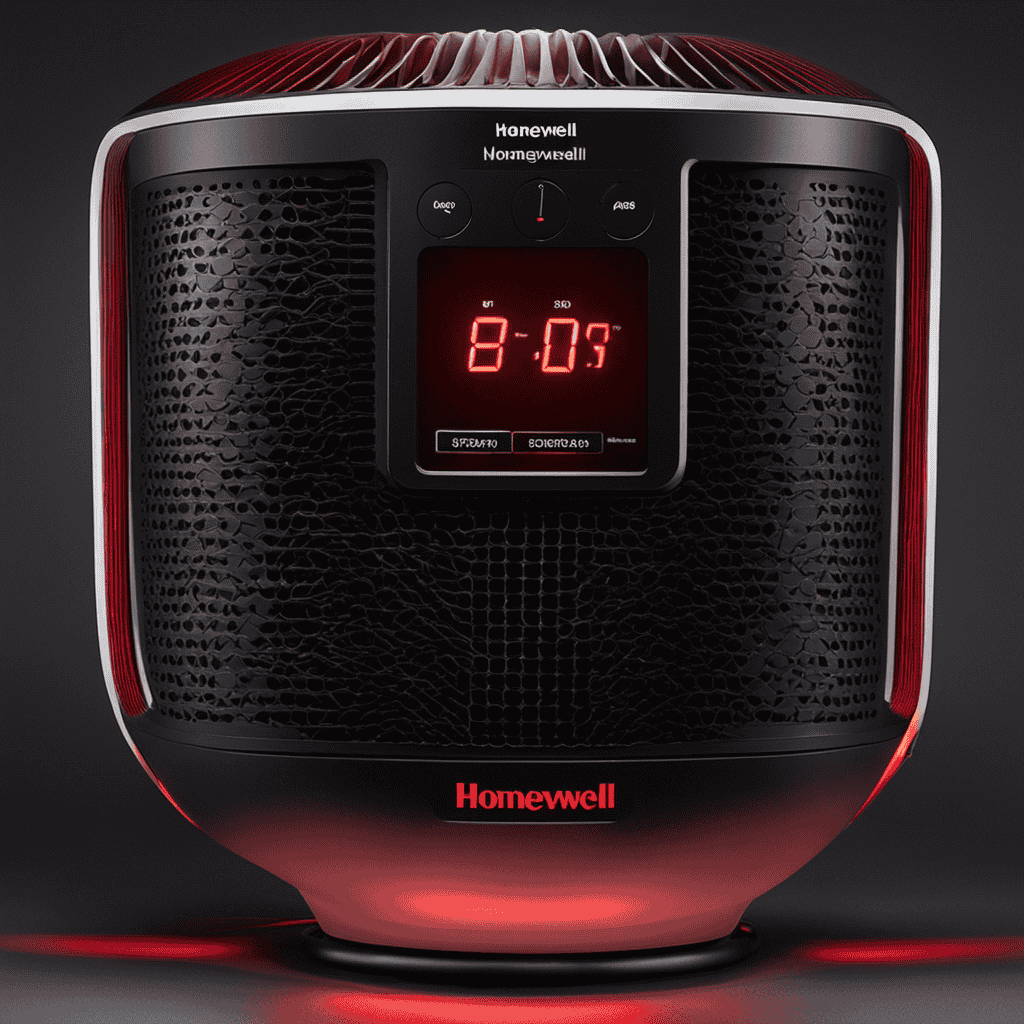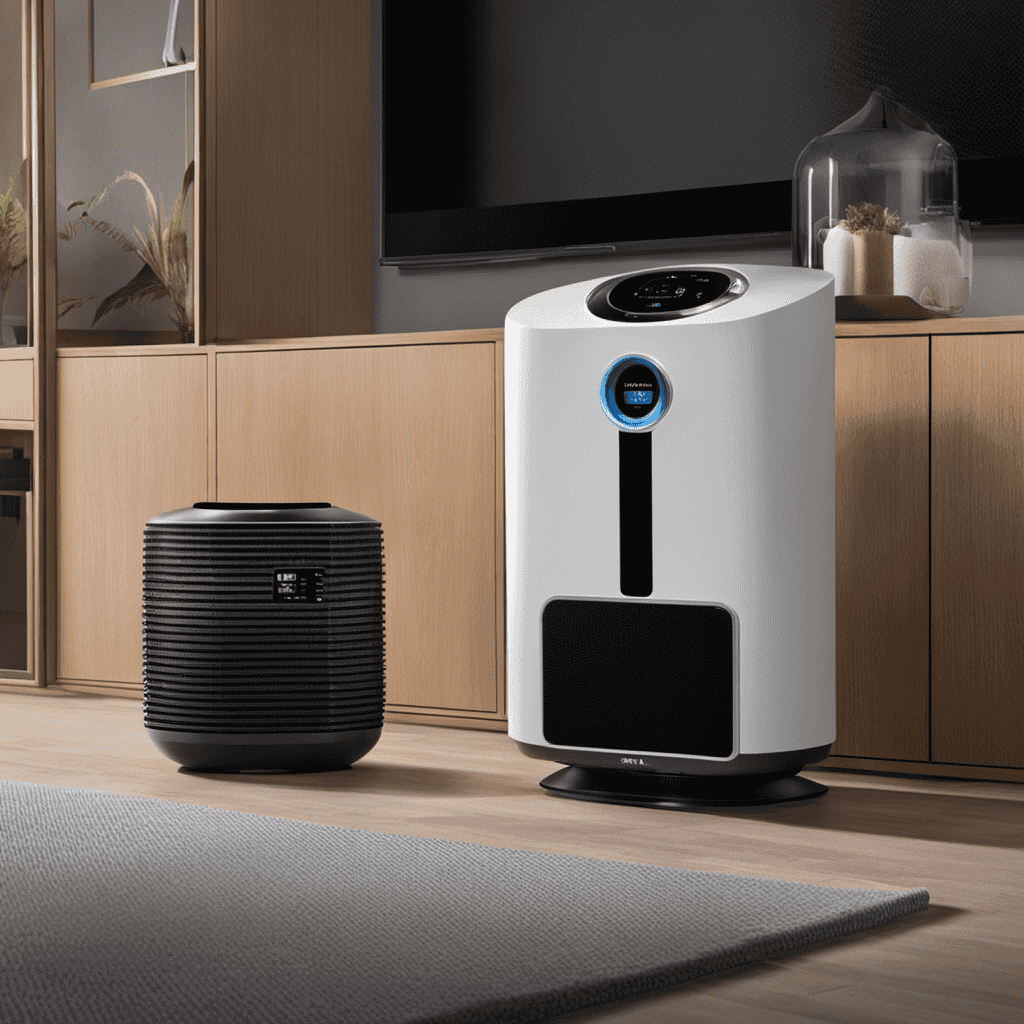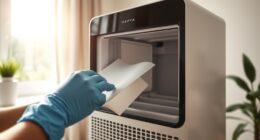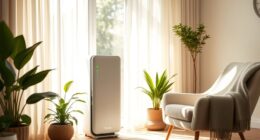Have you ever been curious about what sets a dehumidifier apart from an air purifier? Allow me to illuminate this subject for you.
These two devices may seem similar, but they serve distinct purposes when it comes to improving indoor air quality.
In this article, I will delve into the functionality differences, their impact on health and allergies, energy efficiency, and more.
So, sit tight and get ready to learn all about the nuances of dehumidifiers and air purifiers.
Key Takeaways
- Dehumidifiers remove excess moisture from the air and prevent the growth of mold and mildew, while air purifiers eliminate airborne contaminants like dust, pollen, pet dander, and smoke particles.
- Dehumidifiers are effective in reducing respiratory issues and allergies caused by damp environments, while air purifiers significantly improve overall air quality and reduce allergy symptoms and respiratory problems.
- Dehumidifiers control humidity levels and are effective in smaller spaces, while air purifiers can cover larger areas and capture and eliminate airborne pollutants.
- High moisture levels can trigger asthma attacks and worsen respiratory symptoms, and dehumidifiers create a healthier living environment by reducing humidity, while air purifiers filter out particles and benefit asthma sufferers.
Functionality Differences
The main difference between a dehumidifier and an air purifier is that the former removes excess moisture from the air, while the latter removes airborne contaminants.
Dehumidifiers are designed to target the function of reducing humidity levels in a specific area. They work by drawing in the moist air, cooling it, and condensing the water vapor into a collection tank. This process helps to prevent the growth of mold, mildew, and dust mites, which thrive in damp environments.
On the other hand, air purifiers focus on eliminating pollutants such as dust, pollen, pet dander, and smoke particles from the air. By using filters or other purification technologies, they capture and remove these harmful substances, improving the overall air quality.
Both appliances have distinct health benefits, with dehumidifiers preventing respiratory issues associated with high humidity, and air purifiers reducing allergies and asthma symptoms caused by airborne particles.
Targeted Air Quality Improvement
To improve your indoor air quality, you can use a dehumidifier or an air purifier. Both devices serve different purposes in targeted air purification.
A dehumidifier helps remove excess moisture from the air, reducing the risk of mold and mildew growth. By maintaining optimal humidity levels, it prevents respiratory issues and allergies caused by damp environments.
On the other hand, an air purifier eliminates airborne contaminants such as dust, pollen, pet dander, and smoke particles. This device uses filters or technology like UV light or ionization to capture or neutralize these harmful substances. By removing these pollutants, air purifiers significantly improve the air quality, reducing allergy symptoms, respiratory problems, and even the spread of airborne viruses.
Both devices offer distinct benefits in air quality improvement and can be used in combination for comprehensive purification.
Moisture Control Vs. Airborne Contaminant Removal
For better indoor air quality, you should consider managing moisture levels and removing airborne contaminants. When it comes to functionality comparison, a dehumidifier primarily focuses on controlling humidity levels in the air, while an air purifier is designed to remove pollutants and allergens from the air.
Here are four key differences between the two:
-
Moisture control: Dehumidifiers are effective in reducing excess moisture in the air, which can help prevent mold and mildew growth. Air purifiers do not have this functionality.
-
Airborne contaminant removal: Air purifiers are specifically designed to capture and eliminate airborne pollutants such as dust, pet dander, pollen, and smoke particles. Dehumidifiers do not have this capability.
-
Health benefits: By reducing moisture and preventing the growth of mold and mildew, dehumidifiers can help alleviate respiratory issues and allergies. Air purifiers, on the other hand, can improve overall air quality and reduce the risk of respiratory illnesses.
-
Coverage area: Dehumidifiers are typically more effective in smaller spaces, while air purifiers can cover larger areas.
Managing moisture levels and removing airborne contaminants are crucial for maintaining a healthy indoor environment. Now, let’s explore the impact of these factors on health and allergies.
Impact on Health and Allergies
Managing moisture levels and removing airborne contaminants can have a significant impact on health and allergies.
As someone who has struggled with respiratory health issues, I understand the importance of maintaining clean and dry air. High moisture levels can lead to the growth of mold and mildew, which can trigger asthma attacks and worsen respiratory symptoms. By using a dehumidifier, you can effectively reduce the humidity in your home and create a healthier living environment.
Additionally, an air purifier can help remove airborne pollutants such as dust, pollen, and pet dander, providing further benefits for asthma sufferers. These devices work by filtering out particles from the air, trapping them in filters, and preventing them from being inhaled.
Energy Efficiency and Cost Considerations
When comparing dehumidifiers and air purifiers, two key factors to consider are power consumption and long-term maintenance expenses.
Power consumption comparison involves evaluating how much energy each device uses to operate, which can impact your electricity bill.
Additionally, long-term maintenance expenses encompass the costs associated with regularly replacing filters, cleaning the units, and any necessary repairs.
Understanding these factors is crucial in making an informed decision about which appliance is the most energy-efficient and cost-effective for your specific needs.
Power Consumption Comparison
To compare the power consumption between a dehumidifier and an air purifier, you can easily check the wattage information provided by the manufacturers. This information is usually found on the product label or in the user manual.
When considering energy efficiency, it is important to note that dehumidifiers typically consume more power than air purifiers due to their larger size and more advanced technology. Here are some key points to consider in terms of power consumption:
- Dehumidifiers generally have a higher wattage rating compared to air purifiers.
- The power consumption of dehumidifiers can vary depending on the size and capacity of the unit.
- Air purifiers are designed to run continuously, while dehumidifiers may cycle on and off based on humidity levels.
- Look for energy-saving features such as programmable timers and auto-shutoff functions to reduce power consumption.
Considering the power consumption is just one aspect of the overall cost of owning a dehumidifier or air purifier. It is important to also consider long-term maintenance expenses.
Long-Term Maintenance Expenses
Considering long-term maintenance expenses, it’s important to factor in costs beyond just power consumption when deciding between a dehumidifier and an air purifier. While power consumption is an important consideration, it is equally crucial to analyze the long-term cost comparison and lifespan comparison of these appliances. To help you make an informed decision, I have prepared a table showcasing the key maintenance expenses and average lifespan of dehumidifiers and air purifiers.
| Maintenance Expenses | Dehumidifier | Air Purifier |
|---|---|---|
| Filter Replacement | $30 – $50 | $20 – $40 |
| Cleaning | $0 | $0 |
| Parts Replacement | $50 – $100 | $0 |
| Professional Servicing | $75 – $150 | $0 |
| Total Annual Cost | $155 – $300 | $20 – $40 |
As seen in the table, dehumidifiers generally have higher long-term maintenance expenses due to the need for filter replacements, parts replacements, and occasional professional servicing. On the other hand, air purifiers have relatively lower maintenance costs, primarily limited to filter replacements. Additionally, the average lifespan of dehumidifiers is around 5-10 years, while air purifiers typically last for 3-5 years. Therefore, when considering the long-term cost and lifespan comparison, it is essential to evaluate both factors in order to make the most cost-effective choice for your specific needs.
Size and Portability
If you want a device that you can easily move around your house, opt for a smaller and more portable dehumidifier or air purifier. These compact units provide several portability advantages over their larger counterparts.
Here are four key points to consider when it comes to size and portability:
-
Easy maneuverability: Smaller dehumidifiers and air purifiers are lightweight and often come with built-in handles or wheels, allowing you to effortlessly transport them from room to room.
-
Versatile placement: Due to their smaller size, these devices can fit in tight spaces, such as closets, bathrooms, or small bedrooms, where larger units may not be suitable.
-
Travel-friendly: If you’re planning a trip or need to move the device to a different location, a portable dehumidifier or air purifier can be conveniently packed and transported without much hassle.
-
Limited coverage area: It’s important to note that smaller devices have size limitations and may not be as effective in treating larger spaces. Consider the square footage of the area you want to target before making a purchase.
Noise Level and Operation
When comparing noise levels and operation, it’s important to choose a device that won’t disturb your daily activities. Both dehumidifiers and air purifiers have different noise reduction features and operation modes.
Dehumidifiers usually have a compressor that can produce a humming sound when in operation. However, newer models are equipped with advanced technology that reduces noise levels, making them quieter to use.
Air purifiers, on the other hand, use fans to circulate air through filters, which can generate some noise. Some models have multiple operation modes, such as a sleep mode or low-speed setting, which can reduce noise levels while still maintaining effective performance.
Considering these factors, it’s crucial to select a device that suits your noise tolerance and provides the desired functionality for your specific needs.
Now let’s move on to the next section about maintenance and filter replacement.
Maintenance and Filter Replacement
To keep your device running efficiently, it’s important to regularly maintain and replace the filters. Filters play a crucial role in removing impurities from the air and ensuring clean, healthy indoor environments.
Here are some maintenance tips to extend the filter lifespan and optimize performance:
-
Check the filter regularly: Monitor the condition of the filter and inspect it for any signs of dirt or clogging.
-
Clean or replace as needed: Depending on the type of filter, you may need to clean or replace it. Follow the manufacturer’s instructions for proper maintenance.
-
Keep the surrounding area clean: Dust and debris can accumulate around the device, affecting the filter’s efficiency. Regularly dust and vacuum the area to prevent this.
-
Schedule regular filter replacements: Filters have a finite lifespan, so it’s important to replace them at recommended intervals to maintain optimal performance.
Following these maintenance tips will ensure that your device operates at its best and continues to provide clean, fresh air for years to come.
Choosing the Right Option for Your Needs
When it comes to choosing the right option for your needs, it’s important to consider the differences between a dehumidifier and an air purifier.
A dehumidifier is designed to remove excess moisture from the air, which can help prevent mold growth and improve indoor air quality.
On the other hand, an air purifier is specifically designed to remove impurities such as dust, pollen, and pet dander, which can help reduce allergies and respiratory issues.
It’s important to assess your specific needs and determine whether you require a solution that focuses on humidity control or air purification.
Dehumidifier Vs. Air Purifier
The main difference between a dehumidifier and an air purifier is that the former reduces moisture in the air, while the latter removes contaminants such as dust and allergens. When it comes to functionality comparison, both devices have their advantages and can provide health benefits. Here are four key points to consider:
-
Moisture Reduction: Dehumidifiers are designed to control humidity levels by extracting excess moisture from the air, which can help prevent mold growth and reduce the risk of respiratory issues caused by dampness.
-
Contaminant Removal: Air purifiers, on the other hand, focus on removing particles and allergens from the air, improving indoor air quality and reducing the presence of airborne irritants that can trigger allergies or asthma.
-
Targeted Approach: Dehumidifiers primarily address moisture-related concerns, while air purifiers are specifically designed to tackle air quality issues.
-
Combined Solutions: In some cases, it may be beneficial to use both a dehumidifier and an air purifier in conjunction to achieve optimal indoor air quality and moisture control.
Considering these factors, it is essential to evaluate your specific needs and make an informed decision about which device best meets your requirements for a healthier living environment.
Which Meets Your Needs?
Considering your specific needs, it’s important to evaluate which device best meets your requirements for a healthier living environment. When comparing a dehumidifier and an air purifier, two important factors to consider are energy consumption and air purification technology.
In terms of energy consumption, dehumidifiers typically require more energy to operate compared to air purifiers. This is because dehumidifiers need to remove excess moisture from the air, which requires more power. On the other hand, air purifiers are designed to clean the air by removing airborne particles and pollutants, which typically requires less energy.
When it comes to air purification technology, air purifiers are specifically designed to remove allergens, smoke, dust, and other pollutants from the air. They use filters, such as HEPA filters, to trap these particles and provide cleaner air. Dehumidifiers, on the other hand, focus on reducing moisture levels in the air, which can help prevent the growth of mold and mildew.
Frequently Asked Questions
What Are the Main Factors to Consider When Choosing Between a Dehumidifier and an Air Purifier?
When choosing between a dehumidifier and an air purifier, factors to consider are size of space, desired air quality, and specific concerns (moisture, allergens). Both impact energy consumption and utility costs.
Can a Dehumidifier Also Remove Airborne Contaminants Like an Air Purifier?
Yes, a dehumidifier can help remove some airborne contaminants, but its primary function is to control humidity levels. Air purifiers, on the other hand, are specifically designed to remove a wide range of airborne pollutants for improved indoor air quality.
How Does Using a Dehumidifier or Air Purifier Impact Energy Consumption and Utility Costs?
Using a dehumidifier or air purifier can impact energy consumption and utility costs. They both offer energy efficiency and long-term cost savings. However, understanding their differences is crucial for making an informed decision.
Are There Any Specific Health Conditions or Allergies That Can Be Better Addressed by a Dehumidifier Rather Than an Air Purifier?
Specific health conditions and allergies, such as asthma and dust mite allergies, can be better addressed by a dehumidifier rather than an air purifier. A dehumidifier helps reduce moisture levels that contribute to allergen growth.
What Are the Key Maintenance Requirements for Both Dehumidifiers and Air Purifiers, and How Often Should Filters Be Replaced?
To properly maintain dehumidifiers and air purifiers, regular cleaning and filter replacement are crucial. Filters should be replaced every 3-6 months, or as recommended by the manufacturer, to ensure optimal performance and clean air circulation.
Conclusion
In conclusion, the difference between a dehumidifier and an air purifier is like night and day.
While a dehumidifier tackles the issue of excessive moisture, an air purifier takes on the daunting task of removing airborne contaminants.
These two machines are like superheroes, each with their own unique powers.
The dehumidifier battles against mold and mildew, while the air purifier fights off allergens and pollutants.
So, if you want a clean and dry environment, get yourself a dehumidifier and air purifier – your health and home will thank you!
